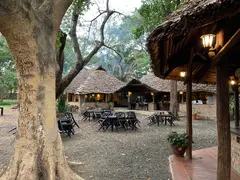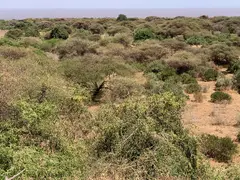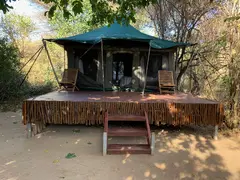 My room creaked loudly this morning, it may have been the light rain which fell
but I was thinking more of giant mosquitoes rattling around. Each twinge or
unexpected feeling I worried was an insect bite. I did share my bed with a spider
or two.
My room creaked loudly this morning, it may have been the light rain which fell
but I was thinking more of giant mosquitoes rattling around. Each twinge or
unexpected feeling I worried was an insect bite. I did share my bed with a spider
or two.
Breakfast was watermelon and bread and an omelette cooked in front of you by a lady with an elaborate headdress. Checked out okay then met my guide “Goodluck” who is a cheery Maasai soul. He drove the safari vehicle which has a roof that can be raised so passengers can stand to see, and helpfully a USB charge point. Inside the parks seat belts weren’t worn so one can stand up.
 We went through African townships where everyone is doing what they can to earn
a living. A saying is eating your leg meaning a lot of people walk to find
work for each day rather like the Bible story. Other groups sit around on
motorcycles waiting for work. A mix of old decayed shacks and new builds
well painted. In places with lots of water people sell flowers and plants
for homes. Fruit like bananas transported into cities from outside.
We went through African townships where everyone is doing what they can to earn
a living. A saying is eating your leg meaning a lot of people walk to find
work for each day rather like the Bible story. Other groups sit around on
motorcycles waiting for work. A mix of old decayed shacks and new builds
well painted. In places with lots of water people sell flowers and plants
for homes. Fruit like bananas transported into cities from outside.
The terrain changed to dusty scrub desert as we entered Maasai desert, saw them wearing traditional costumes. They herd their cattle and goats over vast distances for water and to sell them when they need money. We picked up sandwich boxes at a supermarket place then onto Lake Manyara Park. The main gate was busy with a school party having pictures taken with a sign and many safari vehicles like the one I was in.
 The main gate to
Lake Manyara National Park
had a good toilet block, and also Wi-Fi. The facilities in
the park surprised me: dirt roads bumpy but pretty well maintained, picnic
areas with toilets (I needn’t have worried about not being able to go for
hours). The park itself is land between the large lake and rift valley hills.
Some large trees like tamarind and baobab and blue cordia?, a lot of acacia bushes. A lot of
trees get pushed over by vandal elephants. Dense bush can hide
animals from view. In late September a lot of
dryness so grass brown, river beds dry, mud baths which were just cracked mud
basins.
The main gate to
Lake Manyara National Park
had a good toilet block, and also Wi-Fi. The facilities in
the park surprised me: dirt roads bumpy but pretty well maintained, picnic
areas with toilets (I needn’t have worried about not being able to go for
hours). The park itself is land between the large lake and rift valley hills.
Some large trees like tamarind and baobab and blue cordia?, a lot of acacia bushes. A lot of
trees get pushed over by vandal elephants. Dense bush can hide
animals from view. In late September a lot of
dryness so grass brown, river beds dry, mud baths which were just cracked mud
basins.
Lake Manyara expanded due to heavy rain and as it’s a soda ash lake it killed off a lot of trees by the edge. Some trees are still submerged.
 Guides are very useful - they can spot things like pythons hidden in
dark bushes (I tried to focus but not sure I really saw it). I needed
to practice more with the monocular I took. Guides can decide what is
a rock and what is an animal, what is a bush and what is the shape of
a lying lion. Goodluck spotted a leopard (rare he said) but I didn’t
manage to really focus on it or snap it. It moved away through the bush.
Guides are very useful - they can spot things like pythons hidden in
dark bushes (I tried to focus but not sure I really saw it). I needed
to practice more with the monocular I took. Guides can decide what is
a rock and what is an animal, what is a bush and what is the shape of
a lying lion. Goodluck spotted a leopard (rare he said) but I didn’t
manage to really focus on it or snap it. It moved away through the bush.
The first baboons we saw (trying to steal bananas in the nearby town) was impressive but then one got bored seeing baboons they were so common in the park. Ditto the vervet and blue monkeys, when you’ve seen one you’ve seen them all. We also saw hornbills, an eagle owl, water bucks, water buffalo by the edge of the shrinking lake, impalas, dik-diks which is a pygmy antelope, giraffes, and a brownish bush buck, and on the hit list elephants which sprayed dust over themselves as they crossed the road.
 Lake Manyara Green Camp
may have been green but it was rather basic.
Eerie to be the only guest. No Wi-Fi, no USB charging, shower a bucket
suspended effort, toilet not flushed instead a bucket of leaves
and a trowel. Dinner was out in the dark,
the staff shone a torch to see elephants heading to waterfall for fresh water.
Lake Manyara Green Camp
may have been green but it was rather basic.
Eerie to be the only guest. No Wi-Fi, no USB charging, shower a bucket
suspended effort, toilet not flushed instead a bucket of leaves
and a trowel. Dinner was out in the dark,
the staff shone a torch to see elephants heading to waterfall for fresh water.
The advice was don’t leave your tent at night. I was even afraid to turn on a light at night for fear I would see a lion looking at me. You hear rustling and scufflings and noises like something big pawing at your tent. Definitely an experience.